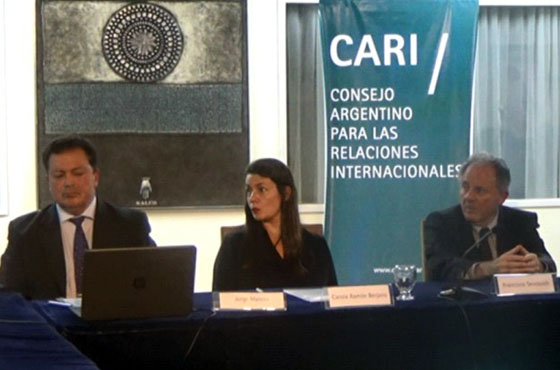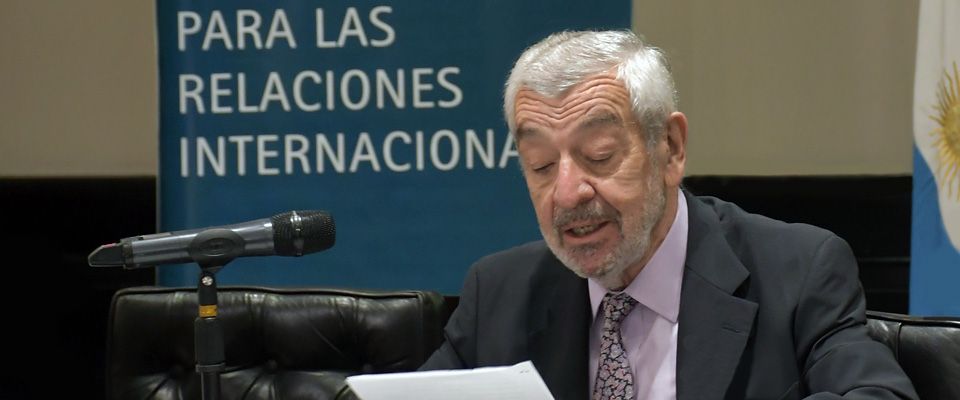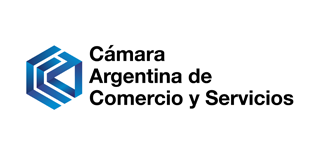
June 6, 2019
A seminar led by Francisco Sercovich, Carola Ramón, and Jorge Malena, organized jointly by the Committee on Science and Technology and the China Working Group
Written by Gabriel Roy
China is an exceptional laboratory for learning development policies in STI...the policy of ‘catching up'Francisco Sercovich
With opening remarks from Mario Mariscotti, Director of CARI's Committee on Science and Technology, the seminar on Chinese innovation first addressed "best routes" for Argentina's advancement in the international order. Mariscotti praised the Committee's attention to Argentinian science, technology, and innovation, adding that the country "has the luck of possessing a strong and competitive scientific base. However, we have not yet had luck applying our research to industry and production". By organizing the seminar, Mariscotti explained that it might be possible to understand all that Argentina can to learn from China, a fundamental partner in an evolving international order.
Prefacing the seminar guests' speeches, Ambassador Eduardo Sadous, Director of the Committee on Asian Affairs, warned that while China is a central world actor, Argentina should not "put all of its eggs in one basket". Sadous advised that Argentina seek out alliances with other countries, especially developing economies, to achieve greater future technological and industrial development. All the same, Sadous recognized that Argentina stands to learn a profound amount from China's example. Sharing an anecdote from a visit to China in 1982, Sadous described a "totally undeveloped" country with "millions of bicycles" and few cars on the streets. Since then, China has experienced "extraordinary" development, Sadous confirmed.
Following Sadous, Dr. Francisco Sercovich, Professor of Politics and Technological Innovation at the University of Buenos Aires, discussed Chinese innovation in depth. Sercovich considers China a model for Argentina, or "an exceptional laboratory for learning the development politics of science, technology, and innovation… [or] the politics of 'catching up'". Despite this, Sercovich explained that it is problematic to try to extract lessons from China's experience and apply them to Argentina, as it is not possible to transfer the historical conditions which paved the way for China's rise. "We're talking about a country of dimensions, culture, and historical trajectory completely different from Argentina's", underscored Sercovich.
At the same time, however, Sercovich highlighted several similarities between China and Argentina: in 2010, China had roughly 50% of the GDP per capita of Argentina, though in 2020 China will match Argentina. Situated in the liminal space between highly developed and less developed countries, China and Argentina belong to a group called "high middle-income countries". Nations in this category suffer from the "middle-income trap", which entails difficulties competing with less developed countries with lower labor costs and with countries of greater technological sophistication. Because of this shared economic challenge, Sercovich stated that Argentina should analyze the ways in which China is tackling the "trap".
Continuing, Sercovich examined the various Chinese models of innovation, distinguishing two paradigms: one entails consistent investments in already established scientific and industrial fields, and the other –specifically pursued by "newcomers"– involves a heuristic "learning-by-doing" process seeking to establish a technological base. As a middle-income country, China finds itself situated in the second category, where Sercovich explained China fights the aforementioned "trap" through three means: first, by maintaining its influential position in global commerce, tech, and investing; second, by prioritizing its efforts to build its research and development fields; and third, by combining its development and innovation initiatives in the scientific, financial, technological, social, institutional, and political sectors.
Offering an example of China's plan for achieving world power, Sercovich next discussed the industrialization of research in China. The new industrial process reduces costs and promotes faster development by dividing research into many "modules" wherein assembly lines are implemented. Such an innovative method has already been applied in China to the fields of pharmaceutics, electronics, and more. Moreover, Sercovich gave the example of "township enterprises", or semistate enterprises of rural original that, powered by millions of workers, pioneered Chinese industrial development in the eighties and nineties.
Today, China is leading in the field of science, technology, and innovation thanks in large part to the country's massive development of designs and patents: according to Sercovich, China has for two years now internationally represented almost 44% of all patents, 96% of utility models, and 50% of industrial designs. Concluding, Sercovich affirmed that "when new frontiers of knowledge are opened, new opportunities are generated, like those that China is now taking advantage of". As much as Argentina has to learn from China, Sercovich emphasized that "it's a two-way street", signalling the future possibility of a reciprocal relationship between China and Argentina.
In the history of mankind, China's economic development over the past forty years has no parallelCarola Ramón
Later, Dr. Carola Ramón, Professor in the School of Oriental Studies of the Universidad del Salvador, gave a general overview of the events which led to China's "dizzying" growth. She cited that today 42% of world e-commerce occurs in China, with over 800,000,000 internet users (more than the EU and the US combined). In turn, she affirmed that "there has never before in human history been a parallel for China's development these past 40 years". Ramón-Berjano further explained that these economic changes arose from China's "Reform and Opening Up" process: beyond the policy's aforementioned industrialization of research and innovation, the reforms also involved extensive investments in China's education system, Chinese universities now leading in international rankings. Moreover, the "special economic zones" developed through the policy have played a key role in the country's industrial transformation.
Focusing much of her speech on these economic zones, Dr. Ramón-Berjano compared them to "a strategy of Lego blocks, which come in many different shapes and colors, and can be assembled in any way. You begin with something small and it soon grows in its depth and reach". Highlighting three different Chinese cities which serve as special economic zones, Ramón-Berjano began with Shenzhen, the oldest and most successful of the zones. Founded in 1980, Shenzhen grew by 58% annually in its first five years of existence; today, the city has a population of 12 million, which rose from a meager 30,000 in 1980, and hosts the country's largest tech firms (Huawei and Tencent, for example). Also of special interest is Zhongguancun, which Ramón-Berjano stated was designed to replicate Silicon Valley and which is home to over 9,000 high-tech companies.
Concluding her speech, Ramón-Berjano spoke of "Made in China 2025", the Chinese Ministry of Industry and Technology's push to develop high-tech industries and products. "Made in China" is actually the first of three stages, with the final goal of completing China's rise to global innovation "superpower-dom" by 2049. The plan focuses on key industrial and technological sectors such as advanced information technology, aerospace equipment, and alternative energy machinery.
One can be sure the PLA has effectively made use of the term 'computerization' to describe the process of transforming its military into a modern force that can operate and dominate in the digital ageJorge Malena
Finally, Dr. Jorge Malena, Professor of Chinese Contemporary Studies at the Universidad del Salvador, began his presentation on China's military revolution. Malena first clarified that the military revolution was first began by the US in its Cold War armament struggle with the Soviet Union; these US military reforms developed into America's first-ever use of high-tech weaponry in the Gulf War, after which point high-tech armament systems forever dominated military operations. Under these new conditions, the Chinese government recognized that its People's Liberation Army (PLA) was technologically and doctrinally behind other world powers. For this reason, as the new millennium began, China began to modernize the PLA, former President Jiang Zemin calling the transformation "an improvement for our geostrategic position".
Unlike past doctrine, the Chinese military revolution emphasized the new implications and opportunities that cyberwar presented, according to Malena. This new form of warfare involves hackers capable of targeting any platform with a computer operating systems, affecting navigation, arms, communication, command, and radar systems alike. To achieve maximum precision and invisibility in this new military scene, the Chinese Office of Intelligence reformulated its military doctrine, prioritizing computerization as its central goal.
Through the first decade of the twenty-first century, China under Xiaoping administration hid its capacities. Later, as Malena explained, China began to demonstrate its military abilities through public ballistic missile testing. At this same time, China's military reforms –which Malena divides into four parts– became apparent: China adopted an active defense policy, placed greater emphasis on training in methods of cyberwarfare, increased its military spending by 10% annually between 2001 and 2016, and expanded the number of soldiers in its reserves. At the end of 2015, President Xi Jinpin announced one of the most profound changes to the PLA: the creation of the PLA Strategic Support Force, the fourth organ of the Chinese military. According to Malena, the Support Force "unified the cybernetics of China's armed forces and gave the PLA capacities of command and control, communication, intelligence, surveillance, and reconnaissance".
In his closing remarks, Malena remarked that the military revolution had afforded China command over the domains of land, air, space, cyberspace, and even the electromagnetic spectrum. For this reason, Malena concluded that "one can be sure the PLA has effectively made use of the term ‘computerization' to describe the process of transforming its military into a modern force that can operate and dominate in the digital age".


























